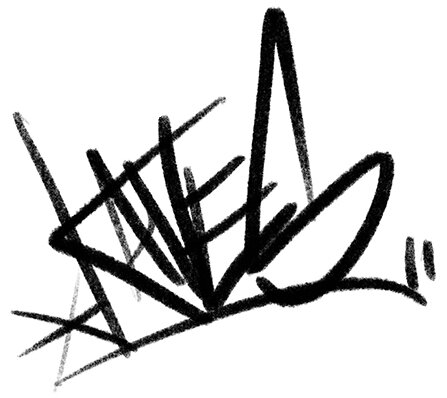Michael ‘KAVES’ McLeer is a man of faith. For McLeer, faith and spirituality are derived not from a theistic higher power but from a rich fabric of personal memories firmly anchored to a sense of place. That place has always been but one: Brooklyn. McLeer’s work has continually been inspired by the crumbling, many-faced Brooklyn of the 1970s and 1980s in which he was born and raised.
McLeer has carried memories of this place in time and spent years recounting them as a kind of folklore through the formats of graffiti, music, and painting. He began making artwork in his early teens illegally spray painting subway trains, buses, and handball courts. This instilled in him a tendency of capitalizing on bold lines, high contrast, and fast mark-making. Graffiti also functioned as a form of storytelling and social commentary. It was a citywide bulletin board, a system of communication, and a platform for the youth for the development of individual fable.
This tradition culminates here. Frenetic blacks, whites, and grays pulsate across sheets of canvas. Closer inspection reveals they are formed by words and sentences. McLeer mines memories and scrawls their impressions in mantra-like repetition. He urges us and himself to give in to discord; revelations often lay under the surface. The series of gestural vistas conveys the solace that was to be found in the brick and concrete labyrinth of McLeer’s childhood neighborhood of Bay Ridge. Urban decay had become a forest of unexpected beauty and solitude. Contained within it were both the claustrophobic quarters of working-class apartment living and the sprawling mazes of girders underneath the Verrazano Bridge- a makeshift playground for trespassing neighborhood children. The enormous inner chambers of its anchorages swallowed them- vast industrial caverns, unidentifiable ceilings fading into darkness. Shadowed walls were canvases to practice painting with a spray can. Its narrow catwalks, shuddering with passing cars and suspended hundreds of merciless feet above water, became a jungle gym from which to steal pigeon eggs. Larger than life was the world around them. Faraway views offered by apartment building rooftops thrust upon them a sense of scale and a possibility to thrive beyond socioeconomic oblivion. Subway trains were steel behemoths from which to learn the letterforms of graffiti- a Sunday school scripture.
McLeer is at once the fable-weaver sitting at the fire and the parishioner praying at the pew. His works are meditative both in its method of application and in its function of purging through visual storytelling. It is the result of recollecting a youth spent within concrete cathedrals, and recounting the mix of real and mythical which accompanied it. In this world, local legends were martyrs and deities. Daydreams and artistic expression were salvation. McLeer’s body of work has routinely endeavored to recount these experiences as both folkloric on the one hand, and on the other, intrinsic to the historical fabric of Brooklyn. From his youth writing graffiti, to his years of songwriting and performing hip hop, to the current era, McLeer has often addressed personal tragedies and joys of urban life and related them as part of the greater narrative of a city. McLeer lives and works in Brooklyn, New York.
